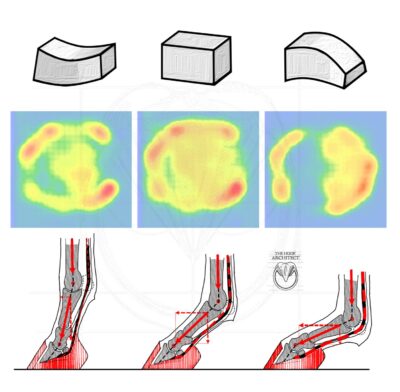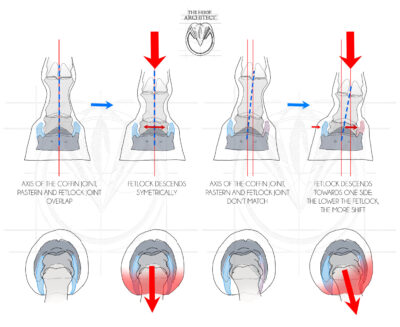single learning post
Limb Conformation, Body Posture and Hoof Capsule Distortions
This two-part webinar series addresses three-dimensional, dynamic hoof balance and the central area of the hoof, an aspect of dorsopalmar balance that is often missed when assessing hoof load distribution.
Part 1 – Dorsopalmar balance and its missing aspects

Hoof balance is three-dimensional and dynamic. Learn how certain aspects of limb conformation and body posture influence load distribution on the hoof, leading to dorsopalmar distortions, and what can be done about them. It is not possible to thoroughly assess balance when focusing only on the hoof capsule and not considering the limb and body above the feet. Dorsopalmar balance is much more complex than just a point between overloaded toes or overloaded heels. Knowing how certain hoof capsule distortions are created and what leads to overload in certain areas of the hoof is helpful when creating a rehab plan and assessing the chances of getting improvement. An important aspect of dorsopalmar balance that is not spoken of is the overload of the central area of the hoof. Get ready for a deep dive into this aspect and learn what leads to distortions in the center of the hoof capsule.
Part 2 – Deep dive into mediolateral balance

Learn what aspects of limb conformation and body posture influence mediolateral balance, how it interconnects with dorsopalmar balance, how to assess conformation and what to do about it. Dorsopalmar and mediolateral balance interconnect and should always be considered together. There are many methods and schools for assessing mediolateral balance but the only reliable way to learn it is to understand what aspects of limb conformation and body posture lead to each type of hoof distortions; then it is easier to understand how to correct distortions and how much correction is enough.
 Ula Krzanowskais, the Hoof Architect, graduated from Technical University of Lodz, got her MSc degree in Architecture and practiced as an architect and illustrator in Poland and the Netherlands for a couple of years while trimming horses, until she decided to follow her passion and fully switch professions. She is now a full-time farrier, horse owner, horse rider, illustrator and researcher. She incorporates her architectural background into her farrier work and hoof care educational projects, aiming to combine both scientific and empirical approaches to get a thorough understanding of hoof morphology and its two-way relationship with conformation and posture.
Ula Krzanowskais, the Hoof Architect, graduated from Technical University of Lodz, got her MSc degree in Architecture and practiced as an architect and illustrator in Poland and the Netherlands for a couple of years while trimming horses, until she decided to follow her passion and fully switch professions. She is now a full-time farrier, horse owner, horse rider, illustrator and researcher. She incorporates her architectural background into her farrier work and hoof care educational projects, aiming to combine both scientific and empirical approaches to get a thorough understanding of hoof morphology and its two-way relationship with conformation and posture.
Ula currently works on all types of horses, from pasture pets to high performance horses, and referral cases from veterinarians. In her free time she travels extensively, developing her own personal research regarding hoof morphology and educational hoof care projects, including online publications as The Hoof Architect.
Type Online
With Ula Krzanowska
When Aug 24, 2024
Cost $100, $175 non-member
Credits 6
/ Status Currently unscheduled.
All clinics
- Anatomy, Trimming and Hoof Protection – Colorado
- Hyperinsulinemia, Laminitis, and PPID: Diagnosis and Management – Part 1
- Hyperinsulinemia, Laminitis, and PPID: Diagnosis and Management – Part 2
- The Smart Way to Feed Horses – Part 1
- Hands-on Reading Radiographs for the Hoof Care Practitioner
- The Smart Way to Feed Horses – Part 2
- Collaboration Between Hoof Care Professionals & Equine Bodyworkers
- How to Create and Manage Your Track System
- Anatomy, Trimming and Hoof Protection – New York
- Advanced Anatomy and Radiographs – Colorado
- Anatomy, Trimming and Hoof Protection – California
- Reading Radiographs for the Hoof Care Practitioner
- Anatomy, Trimming and Hoof Protection – Tennessee
- Advanced Anatomy and Radiographs – Tennessee
- Documenting Hoof Rehabilitation
- Sustaining Your Hoof Care Business
- Anatomy, Trimming and Hoof Protection – Florida
- Anatomy, Trimming and Hoof Protection – Quebec
- Advanced Anatomy and Radiographs – Quebec
- Off to a Good Start: Trimming Foals
- Trimming Donkeys: Trimming Protocol, Hoof Distortion, and Laminitis
- Feeding Performance Horses
- Feeding Pregnant and Growing Horses
- Feeding for Special Needs
- Dr. Bowker on Sound versus Healthy Hooves
- Changes in Coffin Bone Structure and Influence of Trimming
- Wear Patterns, What They Really Mean!
- Starting Your Hoof Care Business
- Dr. Tomas Teskey on the Equine Dental-Body Connection
- Choosing and Fitting Hoof Boots
- EMS (IR) and PPID: Diagnosis and Management
- WTF? What the Founder
- Paige Poss Explores Hoof Distortions and Hoof Related Pain
- Utilizing Hoof Imaging in your Trimming Decisions
- Equine Biosecurity; It’s All About Prevention
- Genetics of Equine Metabolic Syndrome and Laminitis Risk
- Basics of Reading Radiographs
- NRC Plus
- Cushing’s and Insulin Resistance
All of our educational offerings are open to the public.

